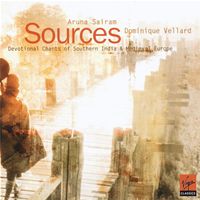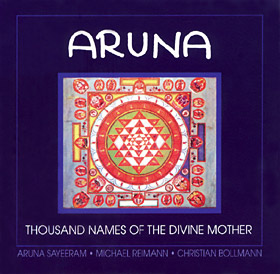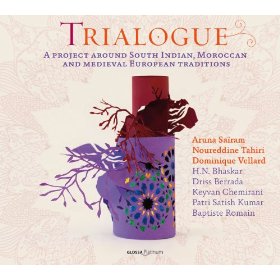Spiritual Transfusion
-

by M.V. Ramakrishnan
“It is necessary for us to reconcile in our minds the apparent contradiction between artistic tradition and innovation and the evolutionary relationship which exists between them. This is a universal phenomenon, which is as complex as the evolution of life itself. Art is also a living organism, which needs to renew itself in order to survive... Innovation, therefore, can never be forbidden. Obviously it would be impossible for anyone to draw an arbitrary line somewhere and say: ‘Thus far, and no further!’ In the last analysis, it all depends only on who innovates, and how... (‘Innovative base of tradition,’ Musicscan, Oct. 9, 2009).
“... Such experiments in innovation can result in fascinating and permissible performances only if the musicians who undertake them are not only well accomplished, but actually function at the highest level of imagination, excellence and integrity. In the case of Carnatic music, it is vitally important that the spiritual quality of the music is never sacrificed.” (‘The logic of fusion,’ Musicscan, Oct. 4, 2010)
I couldn’t help recalling the above opinions expressed by me in this column on past occasions, as I sat mesmerised by Aruna Sairam’s highly innovative vocal recital (labelled ‘fusion’) at the Music Academy’s main auditorium last Saturday evening. The event was organised by the Cancare Foundation, to raise funds for providing effective care to cancer patients.
The main artistic objective of the concert was to demonstrate the amazing melodic similarities between the ongoing classical Hindu tradition of Carnatic music and the historically significant Gregorian Chant, which was the Christian liturgical music tradition of Central and Western Europe during the medieval era preceding the 17th century.
One of the fascinating aspects of Aruna Sairam’s wide-angled musical vision is the way she strives to share the ecstatic experiences and authentic impressions she gains in different, far-flung musical environments with the rasikas, who flock to her concerts.
Thus, with the lilting ‘Kaalinga Narthana Tillana’ (which she has made so popular that music lovers everywhere clamour for it endlessly) Aruna conveys the immense thrill she feels whenever she actually visits the sacred spot in a temple in Oothukkaadu village, where there’s a lovely statue depicting Lord Krishna as a young boy dancing on the hood of the vicious serpent Kaaliya. Similarly, with the rousing Bengali song ‘Jaago Tumi Jaago,’ she gives us a glimpse of the devotional fervour, which overflows in a Durga temple at Kalighat, in Kolkota, at dawn every morning, as the song is recited by a chorus of devotees to wake up the Goddess.
In the same vein, Aruna tried to recall in the concert under review her exciting experience of singing certain Carnatic ragas inside several churches and concert halls in Western Europe, precisely matching the melodies of some Gregorian-Chant verses recited by the distinguished French musician Dominique Vellard, in partnership with whom she has been exploring the intriguing similarities between the melodic patterns prevailing in these totally unrelated musical traditions.
The highlights of the concert were a couple of Gregorian-Chant songs titled, ‘Ave Vergene’ and ‘Rosa Das Rosas,’ with Latin and archaic Italian lyrics respectively. These songs are set to medieval European melodies, which have a close resemblance to the Carnatic ragas, Kalyani and Bhimplas. And Aruna, who rendered the Latin and Italian texts with apparently high fidelity, matched them with Aadi Sankara’s Sanskrit verse ‘Shabda Brahma Mayee’ in Kalyani and Bharatiyar’s Tamil song ‘Vellai Thaamarai’ in Bhimplas.
While the resemblance between the parallel flow of these mutually alien melodies was quite remarkable, no less significant was the close affinity between the devotional spirits of the two different musical systems and cultures. Aruna’s true achievement was to preserve the authentic character and mystic spirit of both traditions equally well, while letting them also crystallise into a common idiom which was saturated with Bhakti. In this sense, the whole exercise was, in my opinion, a case of spiritual transfusion, rather than mere ‘fusion.’
Apart from the phenomenon of similar Carnatic-Gregorian melodic streams, there were certain other significant aspects of this unique performance, including the overall theme (Divine Mother) and the splendid instrumental component. Let us take a close look at them in the next essay in this column.
Related Albums

Sources
Published : 2000
By : EMI Records / Virgin Classics - France
Aruna - Thousand Names...
Published : 1995
By : Lichthaus Music...
Trialogue
Published : 2012
By : Glossa Music
Related Concerts
- Ojai Music Festival 2017
On : Sunday, June 11, 2017 - Bharat Sangeet Utsav 2016 (Jugalbandi)
On : Wednesday, November 9, 2016 - Sammohanam - A celebration of Music and Dance 2017
On : Sunday, February 19, 2017 - Bharat Sangeet Utsav 2019
On : Saturday, November 9, 2019

 Photos
Photos